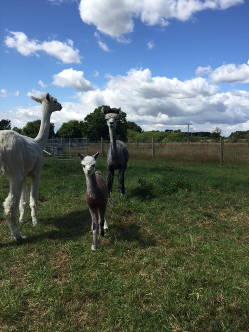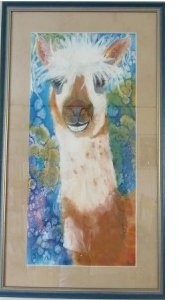Admin
November 2015
Shop Opening Saturday 14th November 2015!
The past few weeks have been gathering pace as I prepare for the grand opening of the Coco Alpacas shop – I’m just a couple of weeks away from this very exciting new enterprise.
It’s been my lifelong ambition to own a shop selling high quality yarn and I’m so excited that it’s finally happening. Continue reading
October 2015
Shop Opening in Church Stretton!
I have some exciting news to announce this month. Church Stretton is getting its very own Coco Alpacas shop in the High Street – and it will be packed with stylish alpaca knitwear and specialists yarns.
I can’t wait to introduce local shoppers and tourists to our fantastic range of accessories, created from the fine fleeces of our loveable alpaca herd. Continue reading
September 2015
A New Home for Asterix and Alfie
I had a poignant moment recently when my lovely black male Asterix and his gorgeous chestnut brown half-brother Alfie – the first babies Asterix cropped ever born in my herd – went to live at South Staffordshire College. Continue reading
August 2015
Surprise!
 What a lovely surprise I had on July 14th, when a beautiful grey cria (baby alpaca) arrived safe and sound, and snuggled up to her proud mum, Keira.
What a lovely surprise I had on July 14th, when a beautiful grey cria (baby alpaca) arrived safe and sound, and snuggled up to her proud mum, Keira.
I knew a baby was on the way, but I had no idea at all of the date. Keira was running with a stud male near Kidderminster in Worcestershire last year, and was pregnant when I bought her in October.
Our new arrival is quite a rarity; she is a stunning shade of grey, and her fleece is looking good at just a few weeks of age. She is a very welcome addition to the herd.
I’ve been so lucky with all my alpaca births so far: my females have given birth naturally without any complications, and the crias have all been good feeders. Alpacas are pregnant for eleven and half months so I imagine its quite a relief for them to give birth! Keira will feed her cria for six months and then she will be weaned.
Alpacas are born outside and if there are no complications it happens very quickly, often within half an hour. They can stay outside afterwards and don’t need to come into the shed unless the weather gets very cold and wet. Crias are normally born in the morning or early afternoon as this enables them to be standing and feeding and to dry off before the night, when the temperature drops. This is important as alpacas originate from the Andes in South America where the temperatures can fluctuate by 40 degrees in a day, being extremely cold at night. Continue reading
July 2015
Three Counties Show
June was a busy month for me and my two alpacas, Felix and Wizard, who accompanied me to the Three Counties Show at Malvern at the weekend of June 13-14.
The event is the largest livestock and equine show in the country and it’s a wonderful showcase for British farming and our rural heritage. Continue reading
June 2015
Cooling off for the summer: my alpacas are ready for shearing!
June is the month my alpacas get to lose their warm winter coats ready for all the lovely weather we hope is coming our way.
My shearing date is 24th June, and my animals will be expertly sheared by Colin Ottery from Devon, who was one of the first alpaca shearers in the country. Continue reading
May 2015
Family planning at the Alpaca Futurity Show!
 As an alpaca breeder, the sector’s shows are of great interest to me, and I love to admire the top quality stud animals available and do some “family planning” for my breeding females.
As an alpaca breeder, the sector’s shows are of great interest to me, and I love to admire the top quality stud animals available and do some “family planning” for my breeding females.
This year I went to the Alpaca Futurity show in Coventry (which champions the best of British alpaca breeding) along with a couple of other Shropshire-based alpaca breeders.
While we were there we had a meeting with one of the UK’s top breeders, Toft Alpacas.
One of their stud males, Toft Timogen (pictured at the front), was best in show for browns and I think he would be a wonderful choice as the sire for next year’s baby alpacas (cria).
I am now waiting to hear how much it will cost to use this handsome stud after his success in the show, so watch this space!
I have six females, so we would hope to get six healthy cria next year after a 11 month gestation period. Usually alpacas have one cria and twins are quite rare. We only have one cria due this year as the other females are having a rest, so next year will be an exciting year when the planned new additions arrive, hopefully full of life and kicking! Continue reading
April 2015

I love all of my alpacas, and I’m always intrigued to get to know each one, as they all have their own individual personalities.
Snowdrop
is a pure white female who used to be the dominant female in my herd, although she now lives in Italy after selling her a couple of years ago.
She was a very independent alpaca and a wonderful mum producing lots of little cria for me.
I will never forget Sonowdrop’s quizzical expression, as she has now been immortalized for me in a fantastic painting which is hanging on my wall. Right next to Snowdrop’s portrait is another painting, and this one is Derby, my fawn and white ‘Alpaca with Attituude’. Derby has the most amazing hairstyle which suits his personality down to the ground. He was quite difficult to halter train, but I perservered, and now he’s as good as gold.
Both of these lovely pictures were painted by a neighbour when I was living in Southern France near the Pyrenees. Gill Masters is an artist who had moved from Kiddermisnter out to France, and at one of my open days she mentioned that she loved painting farm animals. I jumped at the chance to have some fantastic artwork on my wall featuring two of my favourites.
I was so pleased with the results. Gill is a very talented artist and captured Sonwdrop’s searching look and Derby’s crazy hairstyle perfectly!

(If you’d like to see more of Gill’s paintings, visit www.artgallery.co.uk/artist/gillmasters2)
It’s great to have a gift for painting like Gill, but there lots of other ways to be creative too. I like to see what people can create with my alpaca wool, for example. And I thought it would be a great idea to feature a knitting pattern ( or something similar) on my blog every month. This will be starting next month, so watch this space!
If you want to chat to me about the alpaca wool, any of our products, or even the alpacas themselves feel free to visit me at Ludlow market stall, on any of these dates:
Thursday 2nd April
Thursday 16th April
I hope to see you there!
March 2015
This month I’ve got good news for children of all ages, from toddlers right up to young at heart 80 year olds: I have unveiled some beautiful and unique alpaca toys, made from our own alpaca wool.
So many people love the cute appearance of alpacas, and enjoy their soft-textured wool, it made sense to produce these charming cuddlies modelled on my own herd here at Leebotwood. Continue reading
February 2015
Hi. I’m Jane Potts and I’d like to introduce my new blog about life with my herd of gorgeous alpacas!

I used to be a farm secretary until I fell in love with this cuter cousin of the llama at the Royal Show in Warwickshire back in 2007.
Just one look from fabulous Phoebe and her little friend Eliza was enough to convince me my future lay with these fleecy little bundles of fun.
They are the prettiest, fluffiest members of the camel family and are usually sweet tempered and easy to handle. Phoebe and Eliza were pregnant when I bought them, and moved with me to France in 2008, where I bought more female alpacas, increasing my herd to 17.
Beautiful alpaca wool products
It wasn’t long before I started producing luxurious hand knitted products from their fleece. Known as the “fibre of the gods”, alpaca wool is soft and durable, as fine as cashmere, and almost as strong as silk.
The first female cria (baby alpaca) born in France was called Coco, and that’s where the name Coco Alpacas came from. It also seemed appropriate because French fashion designer Coco Chanel was an iconic figure, and alpaca wool is highly prized in the fashion industry.
Coco (the alpaca) had a hole in her heart when she was born, but thanks to my vet in France she survived and thrived after a course of injections in the first week of her life. Continue reading

